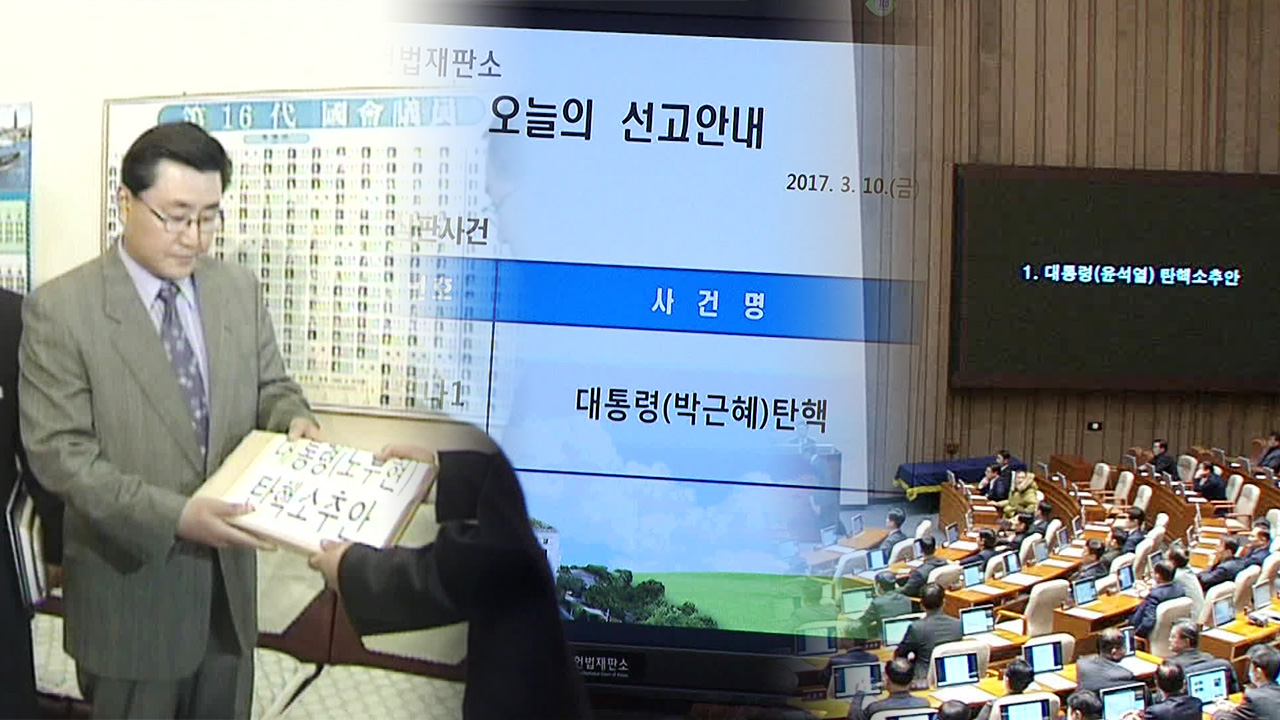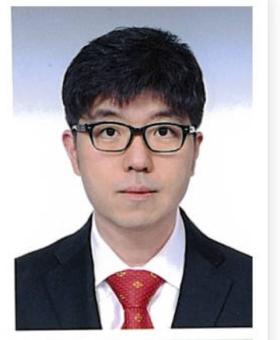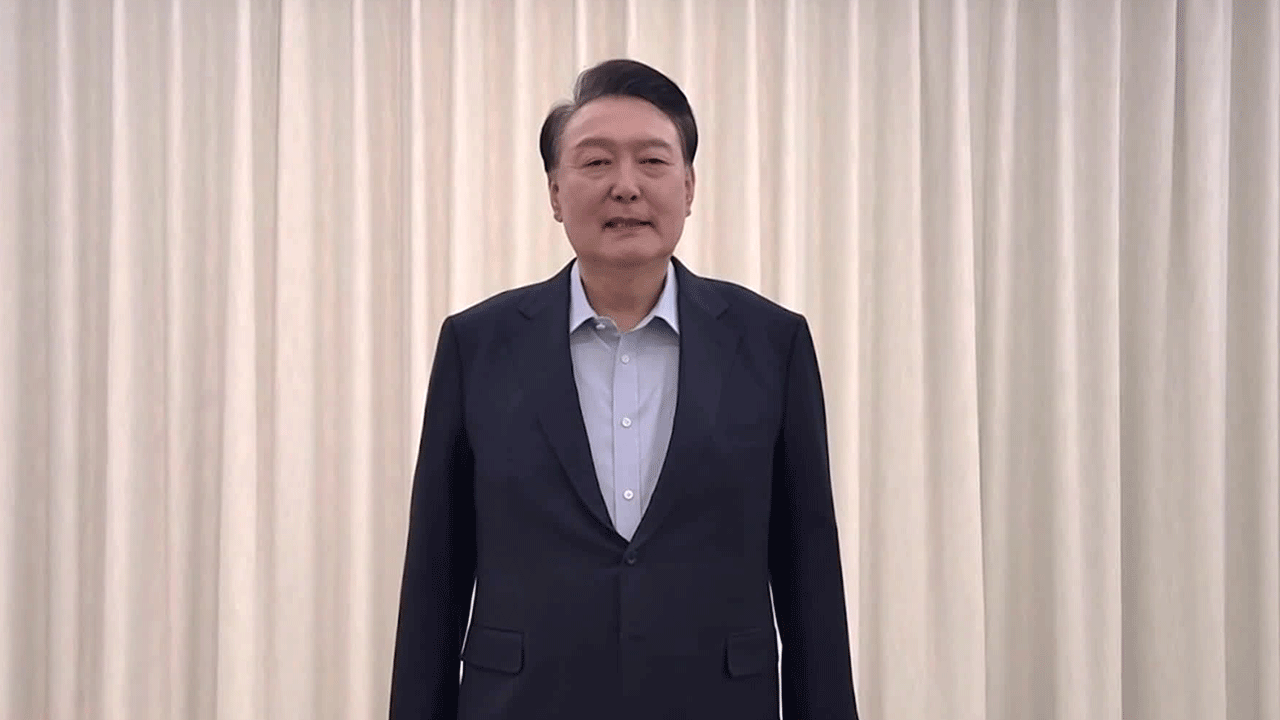Past presidential impeachment motions in South Korean constitutional history
입력 2024.12.15 (00:24)
읽어주기 기능은 크롬기반의
브라우저에서만 사용하실 수 있습니다.
[Anchor]
The second impeachment motion against President Yoon Suk Yeol has passed, marking the third presidential impeachment motion in the history of the constitution to be approved by the National Assembly.
What were the processes of the impeachment motions against former Presidents Roh Moo-hyun and Park Geun-hye in the past, and how did the political landscape unfold afterward? Reporter Choi Dae-soo has the details.
[Report]
In 2004, the impeachment of former President Roh Moo-hyun was initiated.
The impeachment motion was proposed just over a week after the Election Commission urged neutrality due to remarks that were seen as soliciting support from the ruling party.
At that time, the ruling party had only 47 seats, and without the National Assembly Advancement Act, the impeachment motion passed under the leadership of the opposition party.
[Park Kwan-yong/Then Chairman of the National Assembly: "I declare the impeachment motion against President Roh Moo-hyun..."]
However, due to high public opposition to the impeachment and a Constitutional Court ruling that dismissed the motion two months later, former President Roh returned to his duties immediately, and the subsequent general election resulted in a backlash with a 'ruling party majority victory.'
The impeachment motion against former President Park Geun-hye in 2016 was triggered by allegations of a corruption scandal.
Although the ruling party had 128 seats, which was more than during Roh's presidency, at least 28 votes needed to defect from the ruling party for the motion to pass. However, the result exceeded expectations with 234 votes in favor, leading to the passage of the impeachment motion.
[Chung Sye-kyun/Then Speaker of the National Assembly: "I declare that the impeachment motion against President Park Geun-hye has been passed."]
The impeachment trial for President Park took three months.
It took another two months until the 'Cherry Blossom Election.'
The result of the snap election was the victory of the Democratic Party's candidate Moon Jae-in, and the conservative camp was left with a 'trauma' of not only losing power but divisions within the party caused by participation in the impeachment.
Unlike the previous two presidential impeachment motions that passed in one go, this impeachment motion underwent two rounds of voting for the first time in history.
The passage of President Yoon's impeachment motion in the National Assembly marks the third presidential impeachment motion in constitutional history, and the first case where an impeachment motion was passed after being reintroduced.
This is KBS News, Choi Dae-soo.
The second impeachment motion against President Yoon Suk Yeol has passed, marking the third presidential impeachment motion in the history of the constitution to be approved by the National Assembly.
What were the processes of the impeachment motions against former Presidents Roh Moo-hyun and Park Geun-hye in the past, and how did the political landscape unfold afterward? Reporter Choi Dae-soo has the details.
[Report]
In 2004, the impeachment of former President Roh Moo-hyun was initiated.
The impeachment motion was proposed just over a week after the Election Commission urged neutrality due to remarks that were seen as soliciting support from the ruling party.
At that time, the ruling party had only 47 seats, and without the National Assembly Advancement Act, the impeachment motion passed under the leadership of the opposition party.
[Park Kwan-yong/Then Chairman of the National Assembly: "I declare the impeachment motion against President Roh Moo-hyun..."]
However, due to high public opposition to the impeachment and a Constitutional Court ruling that dismissed the motion two months later, former President Roh returned to his duties immediately, and the subsequent general election resulted in a backlash with a 'ruling party majority victory.'
The impeachment motion against former President Park Geun-hye in 2016 was triggered by allegations of a corruption scandal.
Although the ruling party had 128 seats, which was more than during Roh's presidency, at least 28 votes needed to defect from the ruling party for the motion to pass. However, the result exceeded expectations with 234 votes in favor, leading to the passage of the impeachment motion.
[Chung Sye-kyun/Then Speaker of the National Assembly: "I declare that the impeachment motion against President Park Geun-hye has been passed."]
The impeachment trial for President Park took three months.
It took another two months until the 'Cherry Blossom Election.'
The result of the snap election was the victory of the Democratic Party's candidate Moon Jae-in, and the conservative camp was left with a 'trauma' of not only losing power but divisions within the party caused by participation in the impeachment.
Unlike the previous two presidential impeachment motions that passed in one go, this impeachment motion underwent two rounds of voting for the first time in history.
The passage of President Yoon's impeachment motion in the National Assembly marks the third presidential impeachment motion in constitutional history, and the first case where an impeachment motion was passed after being reintroduced.
This is KBS News, Choi Dae-soo.
■ 제보하기
▷ 카카오톡 : 'KBS제보' 검색, 채널 추가
▷ 전화 : 02-781-1234, 4444
▷ 이메일 : kbs1234@kbs.co.kr
▷ 유튜브, 네이버, 카카오에서도 KBS뉴스를 구독해주세요!
- Past presidential impeachment motions in South Korean constitutional history
-
- 입력 2024-12-15 00:24:13

[Anchor]
The second impeachment motion against President Yoon Suk Yeol has passed, marking the third presidential impeachment motion in the history of the constitution to be approved by the National Assembly.
What were the processes of the impeachment motions against former Presidents Roh Moo-hyun and Park Geun-hye in the past, and how did the political landscape unfold afterward? Reporter Choi Dae-soo has the details.
[Report]
In 2004, the impeachment of former President Roh Moo-hyun was initiated.
The impeachment motion was proposed just over a week after the Election Commission urged neutrality due to remarks that were seen as soliciting support from the ruling party.
At that time, the ruling party had only 47 seats, and without the National Assembly Advancement Act, the impeachment motion passed under the leadership of the opposition party.
[Park Kwan-yong/Then Chairman of the National Assembly: "I declare the impeachment motion against President Roh Moo-hyun..."]
However, due to high public opposition to the impeachment and a Constitutional Court ruling that dismissed the motion two months later, former President Roh returned to his duties immediately, and the subsequent general election resulted in a backlash with a 'ruling party majority victory.'
The impeachment motion against former President Park Geun-hye in 2016 was triggered by allegations of a corruption scandal.
Although the ruling party had 128 seats, which was more than during Roh's presidency, at least 28 votes needed to defect from the ruling party for the motion to pass. However, the result exceeded expectations with 234 votes in favor, leading to the passage of the impeachment motion.
[Chung Sye-kyun/Then Speaker of the National Assembly: "I declare that the impeachment motion against President Park Geun-hye has been passed."]
The impeachment trial for President Park took three months.
It took another two months until the 'Cherry Blossom Election.'
The result of the snap election was the victory of the Democratic Party's candidate Moon Jae-in, and the conservative camp was left with a 'trauma' of not only losing power but divisions within the party caused by participation in the impeachment.
Unlike the previous two presidential impeachment motions that passed in one go, this impeachment motion underwent two rounds of voting for the first time in history.
The passage of President Yoon's impeachment motion in the National Assembly marks the third presidential impeachment motion in constitutional history, and the first case where an impeachment motion was passed after being reintroduced.
This is KBS News, Choi Dae-soo.
The second impeachment motion against President Yoon Suk Yeol has passed, marking the third presidential impeachment motion in the history of the constitution to be approved by the National Assembly.
What were the processes of the impeachment motions against former Presidents Roh Moo-hyun and Park Geun-hye in the past, and how did the political landscape unfold afterward? Reporter Choi Dae-soo has the details.
[Report]
In 2004, the impeachment of former President Roh Moo-hyun was initiated.
The impeachment motion was proposed just over a week after the Election Commission urged neutrality due to remarks that were seen as soliciting support from the ruling party.
At that time, the ruling party had only 47 seats, and without the National Assembly Advancement Act, the impeachment motion passed under the leadership of the opposition party.
[Park Kwan-yong/Then Chairman of the National Assembly: "I declare the impeachment motion against President Roh Moo-hyun..."]
However, due to high public opposition to the impeachment and a Constitutional Court ruling that dismissed the motion two months later, former President Roh returned to his duties immediately, and the subsequent general election resulted in a backlash with a 'ruling party majority victory.'
The impeachment motion against former President Park Geun-hye in 2016 was triggered by allegations of a corruption scandal.
Although the ruling party had 128 seats, which was more than during Roh's presidency, at least 28 votes needed to defect from the ruling party for the motion to pass. However, the result exceeded expectations with 234 votes in favor, leading to the passage of the impeachment motion.
[Chung Sye-kyun/Then Speaker of the National Assembly: "I declare that the impeachment motion against President Park Geun-hye has been passed."]
The impeachment trial for President Park took three months.
It took another two months until the 'Cherry Blossom Election.'
The result of the snap election was the victory of the Democratic Party's candidate Moon Jae-in, and the conservative camp was left with a 'trauma' of not only losing power but divisions within the party caused by participation in the impeachment.
Unlike the previous two presidential impeachment motions that passed in one go, this impeachment motion underwent two rounds of voting for the first time in history.
The passage of President Yoon's impeachment motion in the National Assembly marks the third presidential impeachment motion in constitutional history, and the first case where an impeachment motion was passed after being reintroduced.
This is KBS News, Choi Dae-soo.
-
-

최대수 기자 freehead@kbs.co.kr
최대수 기자의 기사 모음
-
이 기사가 좋으셨다면
-
좋아요
0
-
응원해요
0
-
후속 원해요
0















이 기사에 대한 의견을 남겨주세요.